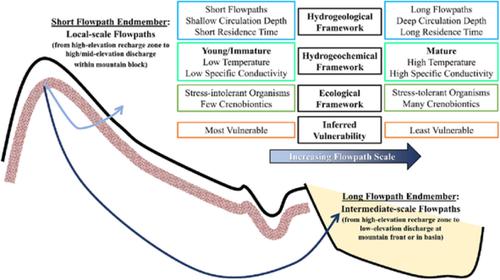当前位置:
X-MOL 学术
›
Hydrol. Process.
›
论文详情
Our official English website, www.x-mol.net, welcomes your
feedback! (Note: you will need to create a separate account there.)
Hydrogeology of desert springs in the Panamint Range, California, USA: Geologic controls on the geochemical kinetics, flowpaths, and mean residence times of springs
Hydrological Processes ( IF 2.8 ) Pub Date : 2020-05-04 , DOI: 10.1002/hyp.13776 Carolyn L. Gleason 1, 2 , Marty D. Frisbee 1 , Laura K. Rademacher 3 , Donald W. Sada 4 , Zachary P. Meyers 1 , Jeffrey R. Knott 5 , Brian P. Hedlund 6
Hydrological Processes ( IF 2.8 ) Pub Date : 2020-05-04 , DOI: 10.1002/hyp.13776 Carolyn L. Gleason 1, 2 , Marty D. Frisbee 1 , Laura K. Rademacher 3 , Donald W. Sada 4 , Zachary P. Meyers 1 , Jeffrey R. Knott 5 , Brian P. Hedlund 6
Affiliation

|
Over 180 springs emerge in the Panamint Range near Death Valley National Park, CA, yet, these springs have received very little hydrogeological attention despite their cultural, historical, and ecological importance. Here, we address the following questions: (1) which rock units support groundwater flow to springs in the Panamint Range, (2) what are the geochemical kinetics of these aquifers, and (3) and what are the residence times of these springs? All springs are at least partly supported by recharge in and flow through dolomitic units, namely, the Noonday Dolomite, Kingston Peak Formation, and Johnnie Formation. Thus, the geochemical composition of springs can largely be explained by dedolomitization: the dissolution of dolomite and gypsum with concurrent precipitation of calcite. However, interactions with hydrothermal deposits have likely influenced the geochemical composition of Thorndike Spring, Uppermost Spring, Hanaupah Canyon springs, and Trail Canyon springs. Faults are important controls on spring emergence. Seventeen of twenty‐one sampled springs emerge at faults (13 emerge at low‐angle detachment faults). On the eastern side of the Panamint Range, springs emerge where low‐angle faults intersect nearly vertical Late Proterozoic, Cambrian, and Ordovician sedimentary units. These geologic units are not present on the western side of the Panamint Range. Instead, springs on the west side emerge where low‐angle faults intersect Cenozoic breccias and fanglomerates. Mean residence times of springs range from 33 (±30) to 1,829 (±613) years. A total of 11 springs have relatively short mean residence times less than 500 years, whereas seven springs have mean residence times greater than 1,000 years. We infer that the Panamint Range springs are extremely vulnerable to climate change due to their dependence on local recharge, disconnection from regional groundwater flow (Death Valley Regional Flow System ‐ DVRFS), and relatively short mean residence times as compared with springs that are supported by the DVRFS (e.g., springs in Ash Meadows National Wildlife Refuge). In fact, four springs were not flowing during this campaign, yet they were flowing in the 1990s and 2000s.
中文翻译:

美国加利福尼亚州帕纳明特山脉的沙漠温泉水文地质:地质化学动力学,流路和平均停留时间的地质控制
加利福尼亚死亡谷国家公园附近的Panamint山脉出现了180多个温泉,尽管这些温泉在文化,历史和生态方面具有重要意义,却很少受到水文地质关注。在这里,我们解决以下问题:(1)哪些岩石单元支持地下水流向Panamint山脉的泉水;(2)这些含水层的地球化学动力学是什么;(3)这些泉水的停留时间是多少?所有的弹簧至少部分地由补给和流经白云岩单元(即,正午白云岩,金斯敦峰组和约翰尼组)支撑。因此,泉水的地球化学成分可以用去脱硅作用来解释:白云石和石膏的溶解以及方解石的同时沉淀。然而,与热液沉积物的相互作用可能已经影响了Thorndike泉,最上层泉,Hanaupah峡谷泉和Trail峡谷泉的地球化学组成。断层是春季出现的重要控制因素。21个采样弹簧中有17个出现在断层处(13个出现在低角度分离断层处)。在Panamint山脉的东部,出现了一些低角度断层相交于近元古生代,寒武纪和奥陶纪沉积单元的泉水。这些地质单位不存在于Panamint山脉的西侧。取而代之的是,在西边出现的弹簧出现在低角度断层与新生代角砾岩和扇形团相交的地方。弹簧的平均停留时间为33(±30)至1,829(±613)年。总共11个弹簧的平均停留时间少于500年,而七个温泉的平均停留时间超过1000年。我们推断,由于Panamint山脉的泉水依赖于当地补给,与区域地下水流的分离(死亡谷地区水流系统DVRFS)以及与之相比受支持的泉水相对较短的平均停留时间,因此极易受到气候变化的影响。 DVRFS(例如,Ash Meadows国家野生动物保护区的温泉)。实际上,在这次竞选期间没有四处流淌,但在1990年代和2000年代却四处流淌。与DVRFS所支撑的泉水(例如Ash Meadows国家野生动物保护区的泉水)相比,平均停留时间相对较短。实际上,在这次竞选期间没有四处流淌,但在1990年代和2000年代却四处流淌。与DVRFS所支持的泉水(例如Ash Meadows国家野生动物保护区的泉水)相比,平均停留时间相对较短。实际上,在这次竞选期间没有四处流淌,但在1990年代和2000年代却四处流淌。
更新日期:2020-05-04
中文翻译:

美国加利福尼亚州帕纳明特山脉的沙漠温泉水文地质:地质化学动力学,流路和平均停留时间的地质控制
加利福尼亚死亡谷国家公园附近的Panamint山脉出现了180多个温泉,尽管这些温泉在文化,历史和生态方面具有重要意义,却很少受到水文地质关注。在这里,我们解决以下问题:(1)哪些岩石单元支持地下水流向Panamint山脉的泉水;(2)这些含水层的地球化学动力学是什么;(3)这些泉水的停留时间是多少?所有的弹簧至少部分地由补给和流经白云岩单元(即,正午白云岩,金斯敦峰组和约翰尼组)支撑。因此,泉水的地球化学成分可以用去脱硅作用来解释:白云石和石膏的溶解以及方解石的同时沉淀。然而,与热液沉积物的相互作用可能已经影响了Thorndike泉,最上层泉,Hanaupah峡谷泉和Trail峡谷泉的地球化学组成。断层是春季出现的重要控制因素。21个采样弹簧中有17个出现在断层处(13个出现在低角度分离断层处)。在Panamint山脉的东部,出现了一些低角度断层相交于近元古生代,寒武纪和奥陶纪沉积单元的泉水。这些地质单位不存在于Panamint山脉的西侧。取而代之的是,在西边出现的弹簧出现在低角度断层与新生代角砾岩和扇形团相交的地方。弹簧的平均停留时间为33(±30)至1,829(±613)年。总共11个弹簧的平均停留时间少于500年,而七个温泉的平均停留时间超过1000年。我们推断,由于Panamint山脉的泉水依赖于当地补给,与区域地下水流的分离(死亡谷地区水流系统DVRFS)以及与之相比受支持的泉水相对较短的平均停留时间,因此极易受到气候变化的影响。 DVRFS(例如,Ash Meadows国家野生动物保护区的温泉)。实际上,在这次竞选期间没有四处流淌,但在1990年代和2000年代却四处流淌。与DVRFS所支撑的泉水(例如Ash Meadows国家野生动物保护区的泉水)相比,平均停留时间相对较短。实际上,在这次竞选期间没有四处流淌,但在1990年代和2000年代却四处流淌。与DVRFS所支持的泉水(例如Ash Meadows国家野生动物保护区的泉水)相比,平均停留时间相对较短。实际上,在这次竞选期间没有四处流淌,但在1990年代和2000年代却四处流淌。











































 京公网安备 11010802027423号
京公网安备 11010802027423号